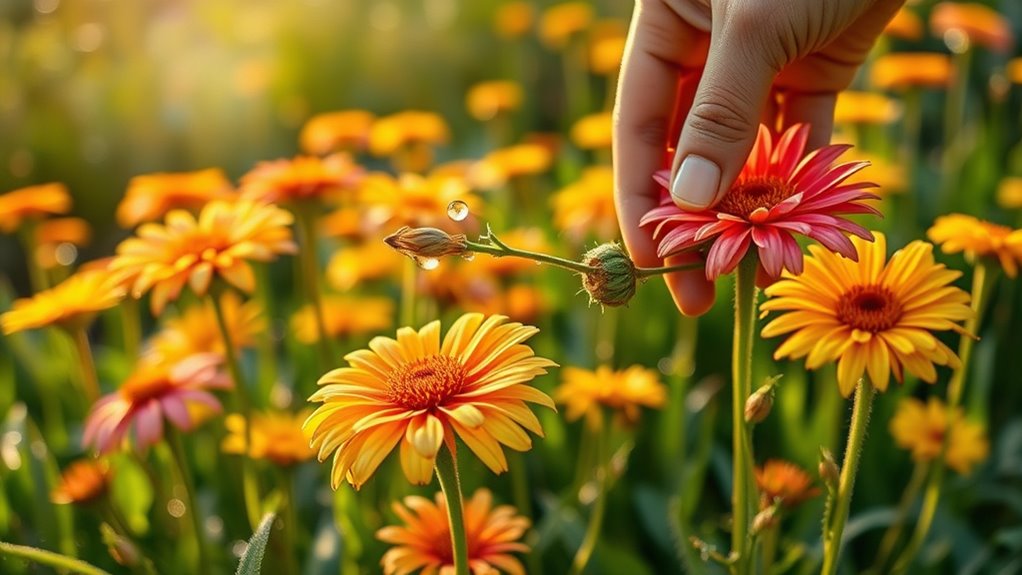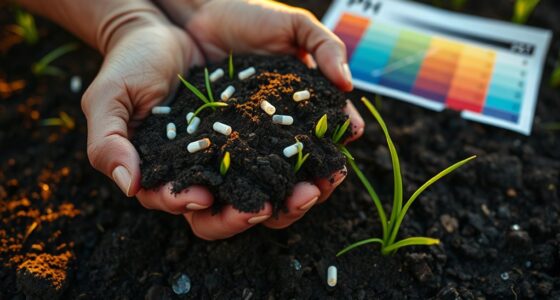Yes, strawflowers are cut-and-come-again plants! They keep blooming when you harvest them properly. To help them thrive, plant in full sun with well-drained sandy soil. Water weekly, but don't overdo it. Regular deadheading boosts blooms, while pruning encourages bushy growth. For the best results, know when to cut for fresh or dried arrangements. If you want to explore more growing tips and care methods, there's plenty more to discover about these vibrant flowers!
Key Takeaways
- Strawflowers are indeed cut-and-come-again, continuously blooming after being cut if properly cared for.
- Harvest stems when 3-4 sets of bracts are open for optimal freshness and longevity.
- Regular deadheading and pruning encourage more blooms and bushier growth throughout the season.
- They thrive in full sun, well-drained soil, and require weekly watering without overwatering.
- For dried arrangements, harvest when a few outer layers of bracts are open and hang upside down to dry.
Understanding the Cut-and-Come-Again Nature of Strawflowers

While you may not have heard of them before, strawflowers are remarkable for their cut-and-come-again nature, meaning they keep blooming even after you cut them.
These annuals thrive from spring to fall, offering a long season of vibrant flowers. To maximize their blooming potential, harvest your flowers when 3-4 sets of bracts are open.
Strawflowers bloom from spring to fall; harvest when 3-4 sets of bracts are open for maximum vibrancy.
Regular deadheading is essential; it encourages the plant to produce more blooms. A balanced fertilizer and consistent moisture will support their growth.
Don't forget to prune or pinch young plants to promote bushy growth. By cutting stems deeply between leaf nodes, you'll signal the plant to keep producing.
Enjoy the beauty and versatility of these resilient flowers in your garden!
Ideal Growing Conditions for Strawflowers
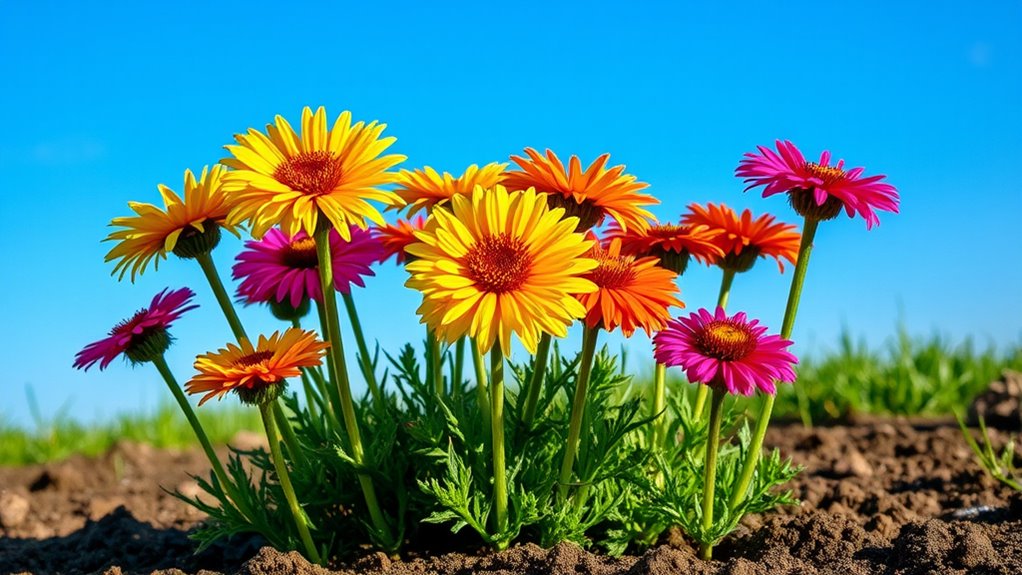
To ensure your strawflowers thrive, it's essential to provide them with the ideal growing conditions. They love full sun, so aim for at least 6-8 hours of direct sunlight each day. While they can tolerate partial shade, too much will lead to leggy stems and fewer blooms.
Use well-drained sandy or rocky soil with a pH between 5.5 and 6.5 to prevent root rot. Water them weekly, but be careful not to overwater. Strawflowers prefer temperatures between 65°F and 70°F during the day, with cooler nights around 60°F.
They also do best in low humidity. With these conditions, your strawflowers will flourish and reward you with vibrant blooms throughout the season.
Effective Planting Techniques for Strawflowers
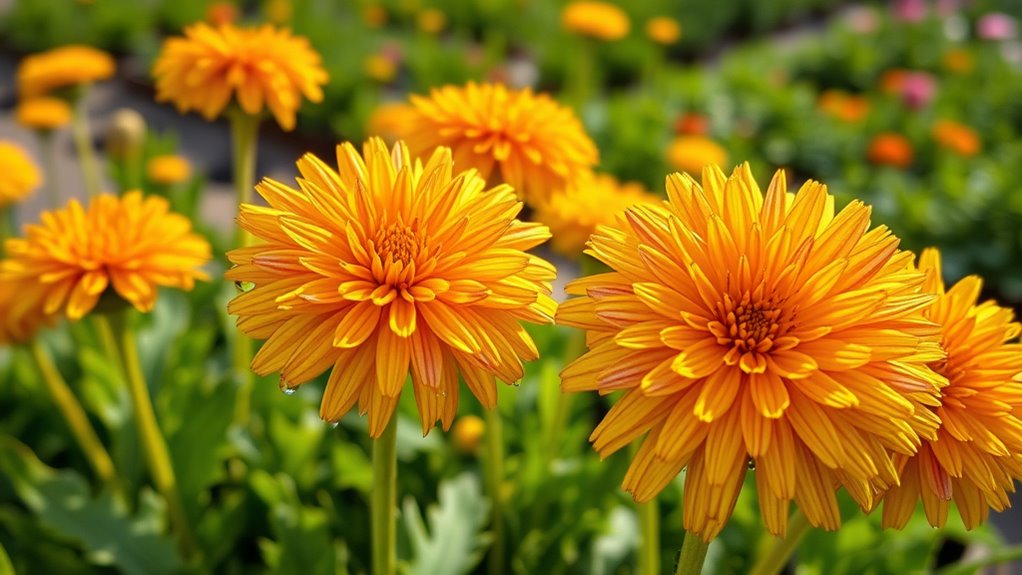
When planting strawflowers, choosing the right seeds and methods can significantly impact your garden's success. Start with a variety that appeals to you, as strawflower seeds come in colors like white, apricot, pink, yellow, orange, and red.
You can sow seeds directly in the ground after the last frost or start them indoors for earlier blooms. Make sure your soil is well-draining; adding mulch can help with moisture retention. Strawflowers thrive in full sun but can tolerate partial shade in hot climates.
If you're planting tall varieties, stake them for support. Remember, seeds need light to germinate, so don't cover them. Keep the soil moist but not waterlogged, and you'll soon enjoy beautiful blooms!
Care and Maintenance Practices for Healthy Growth
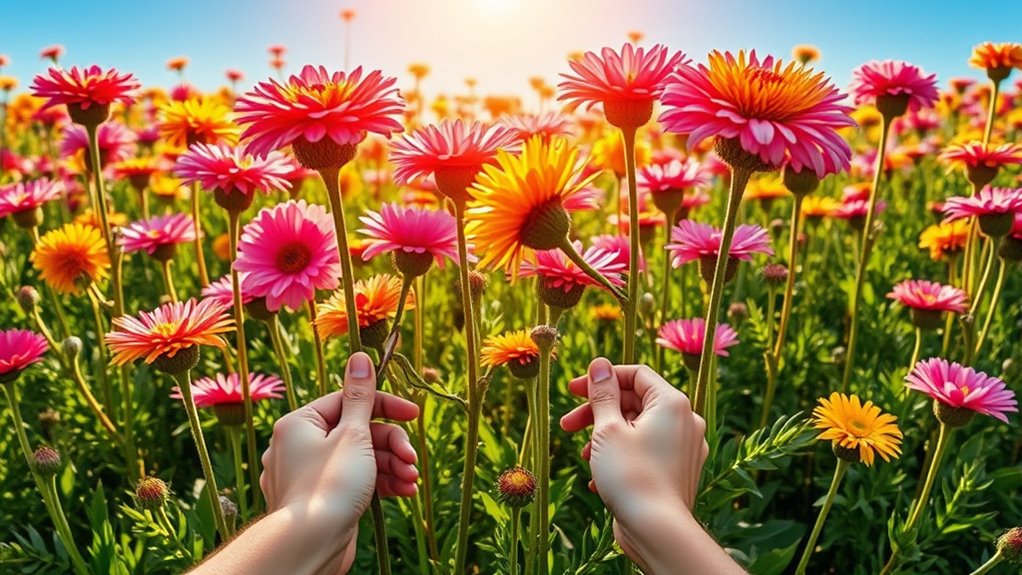
Proper care and maintenance are essential for ensuring your strawflowers thrive and produce vibrant blooms.
Ensuring proper care and maintenance is key for thriving strawflowers and vibrant blooms.
Start by planting them in sandy or rocky soil with a pH of 5.5 to 6.5. Excellent drainage is crucial, so avoid heavy soils that can lead to root rot.
Strawflowers love full sun but can handle partial shade, though this may reduce blooms.
Water weekly, providing about an inch of water, and check the top inch of soil for dryness.
Fertilize monthly with a balanced flower fertilizer, using slow-release options as needed.
Keep an eye out for pests and diseases by monitoring your plants regularly, and maintain proper spacing to promote airflow and reduce disease risk.
Tips for Harvesting Strawflowers for Fresh and Dried Arrangements

Harvesting strawflowers at the right time ensures you get the best quality for both fresh and dried arrangements.
For fresh arrangements, cut the stems when 2-3 layers of bracts are open, but before pollen is visible. Make sure to cut the stems long and remove lower leaves before placing them in water; they'll last 7-10 days without preservatives.
For dried arrangements, harvest when only a few outer layers of bracts are open. Hang your flowers upside down in a warm, dry place with good airflow, using a fan to speed the process.
Handle dry stems carefully, as they can become brittle. Store dried flowers in a cool, dry place, and enjoy their vibrant colors in your arrangements!
Exploring Varieties and Propagation of Strawflowers

To propagate, start seeds indoors 3-6 weeks before the last frost, or sow them directly outdoors afterward.
Ensure optimal germination at 70-75°F.
When transplanting, space seedlings 12-15 inches apart.
With the right care, these varieties will thrive in sunny spots and well-drained soil, rewarding you with beautiful blooms.
Frequently Asked Questions
Can Strawflowers Be Grown in Containers?
Yes, you can grow strawflowers in containers!
Choose pots that are at least 10-12 inches deep with drainage holes to ensure healthy root development. Use a well-draining potting mix and place your containers in a sunny spot, as they need at least 6-8 hours of sunlight daily.
Remember to keep the soil consistently moist but not soggy, and enjoy the vibrant blooms they produce throughout the growing season!
How Long Do Strawflowers Typically Bloom?
Did you know strawflowers can bloom from June to October, lasting up to a week per flower?
You'll enjoy their vibrant colors during this extended period, especially in warmer climates. The bloom duration depends on factors like sun exposure and soil conditions, so ensure they're well taken care of.
Keep deadheading spent blooms, and you might even see them flourish longer, adding beauty to your garden throughout the season!
Are Strawflowers Toxic to Pets?
Strawflowers aren't toxic to pets, so you can plant them without worry.
They're generally safe for cats, dogs, and horses, but keep an eye on your pets just in case. If they happen to munch on a few leaves, it might cause mild gastrointestinal upset.
Always consult your veterinarian if you notice any unusual behavior after ingestion.
Enjoy your garden and the vibrant blooms, knowing your furry friends are safe!
What Pests Are Common With Strawflowers?
When you grow strawflowers, you might encounter pests like aphids, thrips, slugs, and stink bugs.
These pests can distort leaves, stunt growth, and damage blooms. Keep an eye out for cucumber beetles, too.
To manage these nuisances, you can use insecticidal soap or neem oil, apply physical barriers like copper tape, and introduce natural predators like ladybugs.
Regular monitoring helps you catch infestations early, ensuring your strawflowers thrive beautifully.
Can Strawflowers Survive in Partial Shade?
Yes, strawflowers can survive in partial shade, but they truly thrive in full sun.
If you plant them in a partially shaded spot, you might notice fewer blooms and slower growth. To maximize their potential, try to give them at least six hours of sunlight each day.
Just ensure the soil is well-drained, and you'll help your strawflowers stay healthy and vibrant, even in those shadier conditions.
Conclusion
So, you thought strawflowers were just one-and-done blooms? Ironically, they thrive on your snipping! By embracing their cut-and-come-again nature, you'll enjoy a continuous supply of vibrant flowers for both fresh and dried arrangements. With the right care and conditions, these resilient beauties reward your efforts endlessly. Who knew that the more you take, the more they give? In the end, you might find that letting go brings you a garden full of joy.

